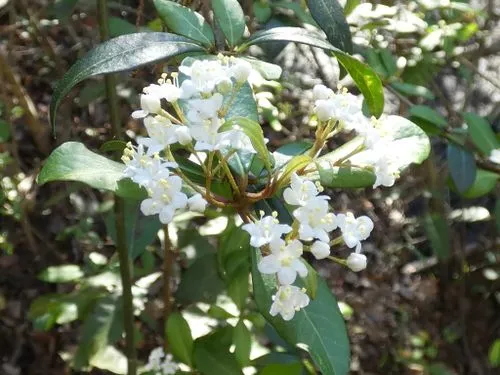Table of Contents for Big-Seed Milkweed (Asclepias macrosperma)
Big-Seed Milkweed (Asclepias macrosperma) is a herbaceous perennial that is native to the four corners region of the United States. This plant is a host to the Queen (Danaus gilippus) and Monarch (Danaus plexippus) butterflies. Growing from 1 to 10 inches tall, this species grows in the sandy soil of washes. The greenish-purple tinged flowers bloom from May to June and the plant is hardy roughly in zones 6-9.
Taxonomy and Naming of Big-Seed Milkweed (Asclepias macrosperma)
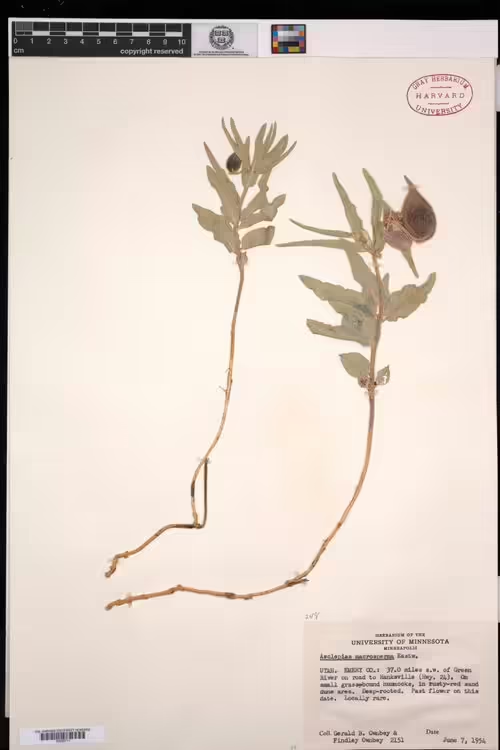
Taxonomy
Big-Seed Milkweed (Asclepias macrosperma) was originally named and described by Alice Eastwood, an American botanist in 1898. It has kept this same name since, however, it has also been considered at times to be a synonym of Asclepias involucrata. This species is a member of the Dogbane Family (Apocynaceae).
Meaning of the Scientific and Common Names
Scientific Name
The genus name, Asclepias, is named for the Greek god of healing, Asklepios (Flora of Wisconsin). The species name, macrosperma, is Latin for big seed.
Common Name and Alternative Names
The common name comes from the big seeds of the plant. Due to its small size and stature this plant has also been called dwarf milkweed. It has also been called Eastwood’s milkweed for the describer of the plant (Heil 2013).
Physical Description
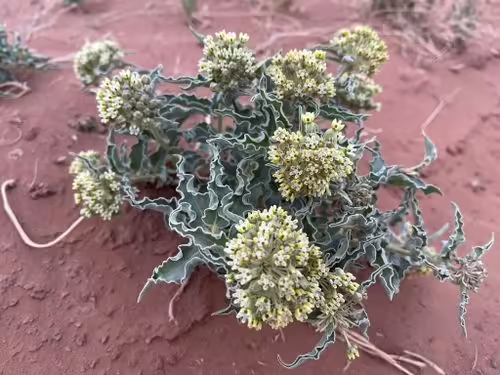
- Plant Type: This plant is a herbaceous perennial.
- Height: 1 to 10 inches tall
- Stem: The stem is erect to reclining and densely tomentose (Woodson 1954).
- Leaves: The leaves are approximate, subsessile, ovate to ovate-lanecolate and are 1 to 2.5 inches long and 0.4 to 1 inches wide. The leaves are densely hairy (Woodson 1954) and have crenate/crisped margins (Heil 2013).
- Flower color: greenish with a purple tinge
- Blooming period: This plant blooms from April to June.
- Fruiting type and period: This plant has follicles that mature in the late summer and fall.
Range of Big-Seed Milkweed in the United States and Canada
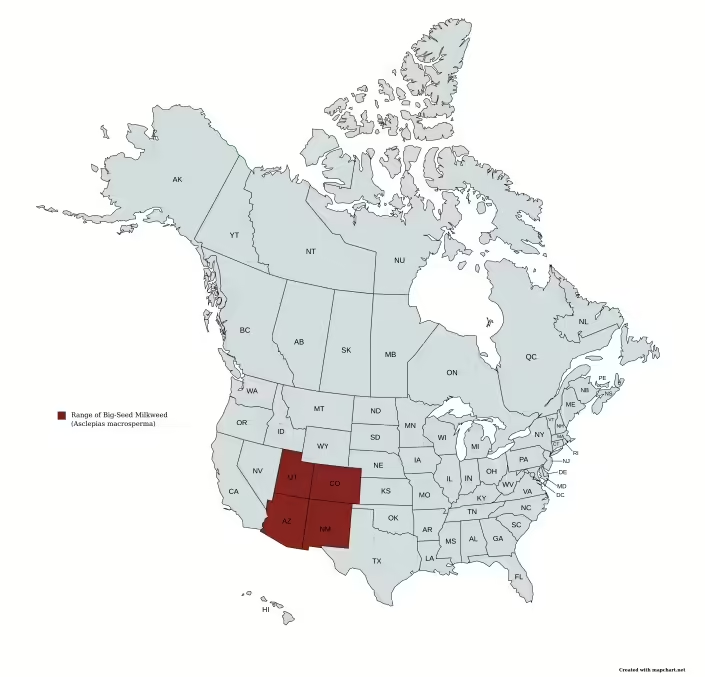
This milkweed species is native to the four corners region of the United States.
Habitat
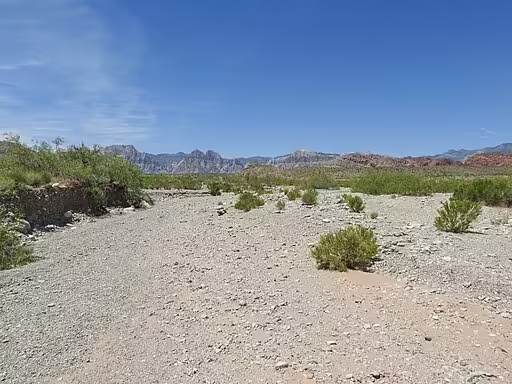
This species grows in the sandy soil of washes.
Hosted Insects
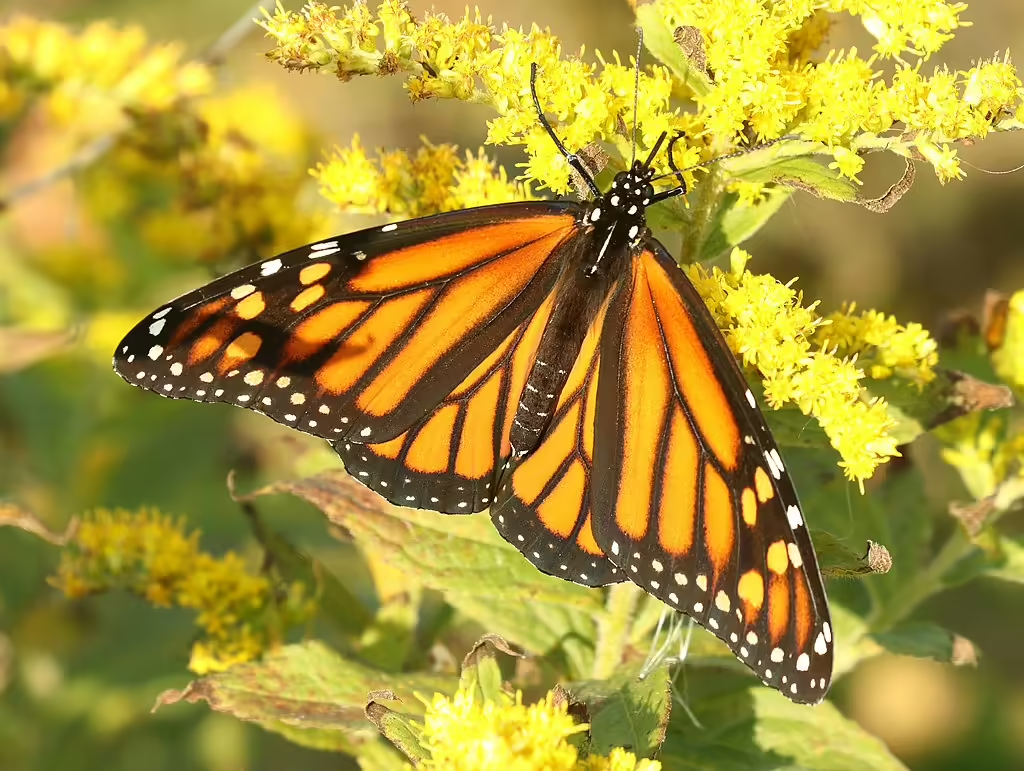
This species is a host for the Monarch Butterfly (Danaus plexippus), the Queen Butterfly (Danaus gilippus).
Other Supported Wildlife

This species is a nectar source to other butterflies, skippers, bees, and wasps during the growing season.
Frequently Asked Questions
Is this plant poisonous?
Like other milkweeds, it has cardiac glycosides (cardenolides) and is considered to be poisonous with ingestion.
Does this plant have any ethnobotanical uses?
The Native American Ethobotanical Database does not cite this species specifically, but milkweeds in general have been used for pharmaceuticals, fibers, and foods.
How is this plant distinguished from other milkweeds?
This species is similar to and has been a synonym of dwarf milkweed (Asclepias involucrata). It differs from A. involucrata, in that big-seed milkweed has coriaceous leaves and has large seeds (Vail 1898).
Is this plant invasive?
This plant has not been noted as being weedy and is restricted to the four corners region in the United States.
Gardening with Big-Seed Milkweed

Hardiness
This species is hardy roughly in zones 6-9. If your garden is within these zones and you have the right growing conditions (soil, moisture and exposure), you may well be able to grow this plant. However, if planted outside of its range, the hosted species may not recognize the plant or be harmed by ingesting a different species with an unfamiliar chemical composition.
Optimal Conditions
This species can grow in full sun to partial-shade in well-drained soil.
References
- Heil, Kenneth D., Steve L. O’Kane, Linda Mary Reeves, and Arnold Clifford. 2013. Flora of the four corners region: vascular plants of the San Juan River drainage, Arizona, Colorado, New Mexico, and Utah. Monographs in Systematic Botany v. 124.
- Kearney, Thomas H. and Robert H. Peebles. 1942. The Flowering Plants and Ferns of Arizona. USDA Miscellaneous Publication 423.
- Vail, Anna Murray. 1898. Studies in the Asclepiadaceae — III. Descriptions of New Species. Bulletin of the Torrey Botanical Club 25(4): 171-182.
- Woodson, Robert. 1954. The North American Species of Asclepias L. Annals of the Missouri Botanical Garden 41: 1-211.
